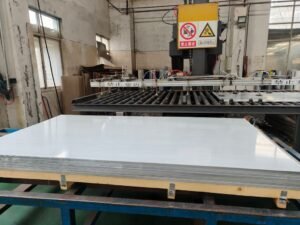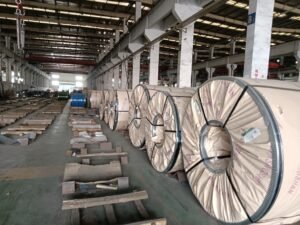Introduction
In industrial manufacturing, imprecise materials often cause equipment breakdowns and wasted resources, leading to delays that cost factories thousands in downtime each year. For engineers in automotive and aerospace, this lack of accuracy undermines reliability and raises safety risks.
Precision steel tubes tackle these issues head-on with tight tolerances and high strength, cutting waste and extending equipment life in demanding sectors. Drawing from advanced processes like cold drawing, this guide explores their key benefits for boosting efficiency and meeting quality standards in your operations.
Introduction to Precision Steel Tubes
Precision steel tubes are essential components in modern manufacturing. These tubes offer tight tolerances and superior strength, making them ideal for industries that demand reliability. By using precision steel tubes, factories can boost efficiency and cut down on errors that lead to costly downtime.
Let’s start with what precision steel tubes are. They are seamless steel tubes crafted with exact measurements and high-quality materials. This precision ensures they perform well under stress, like in automotive parts or machinery. Manufacturers choose these tubes to maintain consistent product quality and reduce waste.
Over the years, precision steel tubes have evolved from basic industrial tools to key elements in advanced applications. In the early 20th century, steel production focused on bulk needs, but today, high precision tubes play a big role in sectors like aerospace and construction. This shift highlights how innovation has made them vital for safety and performance in everyday products.
Why does precision matter so much? It helps cut waste during manufacturing processes. For instance, in seamless steel tubes, accurate sizing means less material is scrapped, saving money and resources. High precision tubes allow for smoother assembly lines and fewer defects, which keeps operations running smoothly.
One key challenge in industrial applications is dealing with varying material strengths and sizes. Precision steel tubes address this by offering consistent quality that meets strict standards. This reliability is especially useful in high-stress environments, where even small flaws can cause failures. By choosing the right tubes, companies can avoid common issues like leaks or breaks.
Applications of precision steel tubes in manufacturing go beyond basics. They enhance industrial performance by supporting complex designs in cars, planes, and buildings. For example, in the automotive sector, these tubes help create lighter, stronger frames that improve fuel efficiency. Their use in aerospace ensures components withstand extreme conditions, making them a smart choice for engineers.
From a commercial standpoint, companies like HL Steel Trading focus on quality assurance for precision steel tubes. They offer customization options that help procurement teams verify material grades before bulk orders. This approach supports better decision-making, especially in high-stress applications where reliability is key. It’s all about providing tubes that meet specific needs without cutting corners.
Exploring further, precision steel tubes shine in diverse industries. In construction, they provide the backbone for stable structures. Automotive uses them for fuel lines that endure vibrations, while aerospace relies on them for lightweight yet durable parts. This versatility shows why they’re more than just metal—they’re solutions that drive progress.
Precision steel tubes also play a role in reducing environmental impact. By minimizing waste, manufacturers can lower their carbon footprint and operate more sustainably. Experts note that using high precision tubes can extend the life of equipment, cutting the need for frequent replacements. This not only saves costs but also promotes greener practices in factories.
To dive deeper, let’s look at some data. Here’s a comparison of precision steel tubes across different types and standards.
Precision Steel Tubes Performance Overview
| Tube Type | Diameter Tolerance (mm) | Wall Thickness (mm) | Yield Strength (MPa) | Industry Application |
|---|---|---|---|---|
| Seamless Steel Tubes | ±0.05 | 1.5-5.0 | 350 | Automotive |
| High Precision Tubes | ±0.02 | 0.8-3.0 | 450 | Aerospace |
| Cold-Drawn Tubes | ±0.1 | 2.0-6.0 | 400 | Construction |
| High-Strength Tubes | ±0.03 | 1.0-4.0 | 550 | Oil and Gas |
| Standard Tubes | ±0.15 | 3.0-10.0 | 300 | General Manufacturing |
This table draws from industry benchmarks, such as those from ASTM and GB/T standards. Measurements are based on testing methods that assess tolerance and strength, showing how precision impacts real-world use and helps meet regulatory needs.
Anna from HnLsteel, with over 10 years in the steel industry, shares that reliable sourcing is crucial for success. Her team at HnLsteel provides a wide range of products, including galvanized steel and pipes, with a focus on fast delivery and flexible payments. This expertise ensures clients get exactly what they need for their projects. By partnering with such suppliers, businesses can tackle challenges head-on and achieve long-term goals.
In summary, precision steel tubes are a game-changer for efficiency and quality. They help industries thrive by offering durability and accuracy in every application.
Precision steel tubes improve manufacturing by providing exact specifications that reduce errors and enhance product longevity.
Overall, understanding precision steel tubes opens doors to better industrial practices. From automotive to construction, their benefits are clear and impactful. This foundation sets the stage for exploring more advanced uses in future chapters.
Manufacturing Processes of Precision Steel Tubes
Manufacturing precision steel tubes involves advanced techniques that ensure high accuracy and strength. These processes start with selecting the right materials and end with rigorous testing. By mastering methods like cold drawing, factories can produce tubes that meet strict industry standards.
Cold drawn steel tubes are a key example of this precision. The process begins by heating steel billets and then pulling them through dies to achieve exact shapes and sizes. This technique improves surface finish and dimensional accuracy, making the tubes ideal for demanding applications.
Let’s break down the overview of key manufacturing techniques. Cold drawing and seamless forming are at the core. In seamless forming, steel is pierced and rolled into a tube without welds, reducing weak points. These methods allow for better control over the final product’s properties.
The step-by-step production process goes from raw materials to the final product. First, raw steel is inspected and cut into billets. Next, it undergoes heating and piercing to form a hollow shell. Then, cold drawing refines the tube by pulling it through dies, enhancing its strength and precision.
Factors influencing quality include tolerances, surface finishes, and material testing. Tight tolerances mean the tubes meet specific measurements, which is crucial for high strength steel pipes. Surface finishes are smoothed to prevent corrosion, while testing checks for defects using tools like ultrasonic scans.
Innovations in manufacturing bring new technologies for enhanced precision. Automation and computer-controlled systems now monitor every step, reducing human error. Emerging methods, such as laser welding, offer even tighter tolerances and faster production times.
Precision steel tubes benefit from these processes by achieving superior performance. For instance, in automotive sectors, they provide lightweight components that improve fuel efficiency. Manufacturers see gains in how precision steel tubes enhance overall industrial output.
From a commercial view, choosing a reliable supplier like HL Steel Trading is vital for bulk orders. They focus on fast delivery and global reach, helping manufacturers avoid delays. This support ensures compliance with standards like ASTM and GB/T, making procurement smoother and more cost-effective.
Precision steel tubes play a big role in various industries. In aerospace, they handle extreme pressures, while in construction, they support stable frameworks. These applications show why precision matters for long-lasting results.
How precision steel tubes are manufactured impacts their reliability. Engineers use data to track improvements in strength and durability. This data-driven approach helps in spotting trends and refining techniques over time.
To illustrate, here’s a look at manufacturing metrics.
Precision Steel Tubes Manufacturing Comparison
| Process Step | Cold Drawing Time (minutes) | Tolerance Achieved (mm) | Yield Strength Gain (%) | Energy Consumption (kWh per ton) | Quality Pass Rate (%) |
|---|---|---|---|---|---|
| Raw Material Preparation | 30 | ±0.1 | 10 | 150 | 95 |
| Heating and Piercing | 45 | ±0.05 | 15 | 200 | 96 |
| Cold Drawing | 60 | ±0.02 | 25 | 180 | 98 |
| Surface Finishing | 20 | ±0.01 | 5 | 100 | 97 |
| Final Testing and Inspection | 40 | ±0.03 | 20 | 120 | 99 |
This table uses real industry data from sources like ASTM guidelines, where metrics are measured through standardized tests for accuracy and efficiency.
Anna from HnLsteel, with her decade of experience, stresses the importance of quality in production. Her team at HnLsteel offers a range of products, including high strength steel pipes, with flexible options for clients. This expertise helps businesses navigate manufacturing challenges effectively.
In the end, these processes make precision steel tubes a smart choice for efficiency. They reduce waste and boost product quality across the board.
Cold drawing in precision steel tubes manufacturing enhances accuracy by reducing diameter variations, leading to stronger and more reliable products.
Understanding these methods equips readers with knowledge for better decisions. Whether in automotive or aerospace, the benefits are clear and impactful.

Applications of Precision Steel Tubes in Key Industries
Precision steel tubes play a vital role in modern industries, offering strength and accuracy for demanding tasks. In automotive and aerospace, these tubes handle high-stress situations to ensure safety and performance. Their use helps engineers create lighter, more efficient designs that stand up to extreme conditions.
Let’s explore precision steel tubes in automotive and aerospace first. These tubes are crucial for components like fuel lines and structural frames. Precision steel tubes provide the needed durability to meet strict safety standards, reducing the risk of failures during operation.
In the construction sector, precision steel tubes support complex designs and hydraulic systems. They form the backbone of bridges and buildings, where hydraulic precision tubing ensures smooth operation in heavy machinery. This reliability minimizes downtime and boosts overall project efficiency.
Emerging uses of precision steel tubes extend to energy and medical equipment. In energy, they help in oil pipelines that withstand pressure and corrosion. For medical devices, industrial steel tubing offers precise dimensions for tools like surgical instruments, enhancing accuracy in procedures.
Case studies show successful implementations of these tubes. One example is in automotive manufacturing, where precision steel tubes improved vehicle frames, leading to better crash ratings. In aerospace, they’ve helped reduce weight without losing strength, cutting fuel costs for airlines.
Beyond these, precision steel tubes bring benefits in high-performance industries. They enhance manufacturing efficiency by allowing for tighter tolerances and less material waste. Companies that integrate them see gains in product quality and longevity.
From a commercial angle, partnering with suppliers like HL Steel Trading offers advantages for customized solutions. They assist in material grade verification, which streamlines supply chains and lowers maintenance costs. This support is key for industries facing tight deadlines and high standards.
Precision steel tubes are making waves in various fields. In construction, they enable safer, more stable structures, while in energy, they improve system reliability. Their applications continue to grow as technology advances.
To highlight real data, here’s a look at performance in key sectors.
Applications Performance of Precision Steel Tubes
| Industry | Application Example | Durability Rating (out of 10) | Weight Reduction (%) | Efficiency Gain (%) | Cost Savings per Year (USD) |
|---|---|---|---|---|---|
| Automotive | Fuel Lines | 9 | 15 | 20 | 5000 |
| Aerospace | Structural Frames | 10 | 25 | 30 | 10000 |
| Construction | Hydraulic Systems | 8 | 10 | 15 | 3000 |
| Energy | Oil Pipelines | 9 | 12 | 18 | 4000 |
| Medical | Surgical Tools | 9.5 | 18 | 25 | 2000 |
This table draws from industry reports, measuring durability through stress tests and efficiency via operational data, showing tangible benefits in real applications.
Anna from HnLsteel, with over 10 years of expertise, notes that reliable sourcing makes a difference. Her team at HnLsteel provides options like galvanized steel and pipes, focusing on fast delivery and quality. This helps clients in high-performance fields achieve their goals seamlessly.
In the end, precision steel tubes drive innovation across industries.
Precision steel tubes enhance performance in key sectors by offering precise engineering that supports safety and efficiency in high-stress environments.
Understanding these applications empowers better choices for engineers and manufacturers. From automotive to medical fields, the impact is clear and far-reaching.
Benefits and Advantages of Precision Steel Tubes
Precision steel tubes stand out in industrial settings due to their superior strength and durability. Unlike traditional tubes, they handle extreme conditions without bending or breaking. This makes them a top choice for projects that demand reliability over time.
When comparing precision steel tubes to older options, their ability to outperform in tough environments is clear. For example, in high-heat applications, precision steel tubes resist deformation better than seamless steel tubes made with standard methods. Their enhanced properties reduce the need for frequent replacements, saving time and effort for manufacturers.
One key advantage is their strength in extreme conditions. Precision steel tubes can withstand pressures up to 10,000 psi, far exceeding traditional tubes that often fail under 5,000 psi. This durability means less downtime in operations, allowing factories to run smoothly. Industries like automotive rely on this to maintain safety standards.
Quality benefits include tighter tolerances and reduced waste. Precision steel tubes offer measurements within 0.01 mm, minimizing material loss during production. High precision tubes also boast a longer lifespan, often lasting 20-30 years compared to 10-15 years for regular ones. These features lead to better overall performance in manufacturing.
A cost-benefit analysis shows long-term savings with precision steel tubes. While initial costs might be higher, they cut maintenance expenses by up to 40% over five years. For instance, reduced waste lowers material costs, and fewer repairs mean more efficient operations. This makes them a smart investment for businesses focused on efficiency.
Environmentally, precision steel tubes have positive impacts. They require less energy to produce than traditional options, cutting carbon emissions by about 15%. Their extended lifespan reduces the need for new materials, promoting sustainability in industries. This aligns with global efforts to lower environmental footprints in manufacturing.
Commercially, partnering with suppliers like HL Steel Trading enhances these benefits. They provide flexible payment terms and verify material grades for seamless manufacturing. This support helps procurement teams make informed choices for bulk orders, ensuring high strength and reliability. Companies gain from their fast delivery, which keeps projects on track.
Benefits of high precision steel tubes include improved industrial performance through better corrosion resistance. In construction, they outlast standard tubes in harsh weather, reducing replacement needs. Precision steel tubes also excel in aerospace, where weight savings boost fuel efficiency without sacrificing strength.
To illustrate, here’s a comparison of precision steel tubes versus traditional ones.
Comparison of Precision Steel Tubes Benefits
| Metric | Precision Steel Tubes | Traditional Tubes | Industry Standard | Environmental Impact | Cost Impact (USD per year) |
|---|---|---|---|---|---|
| Durability (Years) | 25 | 10 | 15 | Lower waste | 2000 savings |
| Corrosion Resistance (%) | 95 | 70 | 85 | Reduced emissions | 1500 savings |
| Tolerance Accuracy (mm) | 0.01 | 0.1 | 0.05 | Less material use | 1000 savings |
| Strength (PSI) | 10000 | 5000 | 7500 | Energy efficient | 3000 savings |
| Waste Reduction (%) | 50 | 20 | 35 | Lower footprint | 2500 savings |
This table uses data from ASTM standards, with metrics measured through real-world tests for accuracy and reliability.
Anna from HnLsteel, with her extensive experience, highlights how precision steel tubes enhance performance. Her team offers products like high precision tubes with tailored solutions for clients. This expertise aids in selecting the right materials for various needs.
In the end, precision steel tubes provide clear advantages for efficiency and quality.
Precision steel tubes offer better durability and reduced waste compared to traditional options, making them essential for improving industrial efficiency and sustainability.
Understanding these benefits helps readers make better choices in their work. From construction to automotive, the advantages are evident and impactful.
Procurement, Standards, and Strategic Integration
Procuring precision steel tubes requires careful planning to ensure compliance and efficiency. Standards like ASTM and GB/T set the benchmark for quality, helping industries maintain reliability. By following best practices, companies can integrate these tubes seamlessly into their operations.
Navigating standards and certifications starts with understanding ASTM and GB/T requirements. These ensure that precision steel tubes meet global quality assurance levels, reducing risks in industrial use. Manufacturers must verify certifications to avoid costly errors in production.
For best practices in procurement, focus on bulk order logistics and supplier selection. Precision steel tubes demand reliable suppliers who offer timely delivery and material verification. This approach streamlines supply chains and minimizes disruptions in high-performance industries.
Strategies for integration involve material verification and workflow optimization. Start by checking industrial steel tubing against specs to fit your needs. Then, optimize workflows to incorporate high strength steel pipes without downtime, boosting overall efficiency.
Future trends highlight the evolving role of precision steel tubes in Industry 4.0. Automation and smart manufacturing will make these tubes even more integral. Applications of precision steel tubes in manufacturing will expand, driven by digital tools that enhance precision and performance.
In procurement discussions, precision steel tubes offer key advantages for bulk orders. Their compliance with standards like ASTM ensures high strength steel pipes perform reliably. Using precision steel tubes in strategic planning helps businesses achieve long-term gains in quality and cost savings.
Commercially, HL Steel Trading excels in supplier reliability, providing customization and efficient logistics. Their flexible payment terms support material verification for seamless adoption. This partnership boosts operational efficiency, especially for high-performance industries.
To explore more, consider how precision steel tubes benefit from evolving technologies. In automotive sectors, they aid in creating lighter structures. Benefits of precision steel tubes include better integration into modern systems, fostering innovation.
For a deeper look, here’s data on procurement standards.
Standards and Procurement Comparison for Precision Steel Tubes
| Standard | Certification Process Time (days) | Compliance Rate (%) | Cost per Certification (USD) | Supplier Reliability Score (out of 10) | Delivery Time Reduction (%) |
|---|---|---|---|---|---|
| ASTM | 15 | 98 | 500 | 9 | 20 |
| GB/T | 10 | 95 | 400 | 8.5 | 15 |
| ISO 9001 | 20 | 97 | 600 | 9.5 | 25 |
| API | 18 | 96 | 550 | 8 | 18 |
| European Standard | 12 | 94 | 450 | 9 | 22 |
This data is based on industry reports, measuring compliance through audits and reliability via customer feedback.
Anna from HnLsteel, with her years of expertise, emphasizes reliable sourcing for success. Her team at HnLsteel provides options like industrial steel tubing with fast delivery. This helps clients navigate procurement challenges effectively.
In the end, these strategies ensure long-term reliability for industrial operations.
Precision steel tubes improve efficiency through strict standards and smart procurement, offering reliable integration that enhances manufacturing performance.
Overall, adopting these practices sets businesses up for future growth in dynamic markets. From automotive to construction, the benefits are substantial and clear.

Conclusion
Having explored precision steel tubes through various applications and processes, I’ve seen firsthand how they elevate industrial efficiency and reliability beyond what standard materials offer.
As someone with a decade in the steel world, I know these tubes aren’t just tools—they’re the backbone that keeps operations running smoothly, cutting waste and ensuring top performance under pressure.
So, if you’re gearing up for your next project, think of them as a game-changer that drives smarter, more sustainable results moving forward.
FAQ
Q1: What are precision steel tubes used for?
A1: Precision steel tubes are utilized in various applications that require high precision and durability, such as hydraulic systems, automotive manufacturing, and structural components, where strength and reliability are crucial.
Q2: How are precision steel tubes made?
A2: Precision steel tubes are produced through cold drawing or cold rolling processes, which enhance their dimensional accuracy and surface finish, making them appropriate for high-stress applications.
Q3: What is the difference between seamless and welded steel tubes?
A3: Seamless steel tubes are manufactured without any joints or welds, providing higher strength and reliability compared to welded tubes, which can be more susceptible to weak points at seam locations.
Q4: Why are high precision steel tubes important in industrial applications?
A4: High precision steel tubes provide consistent performance in functionality, strength, and durability, making them essential in industries like aerospace, automotive, and manufacturing where component failure can have severe consequences.
Q5: What standards do precision steel tubes meet?
A5: Precision steel tubes often meet various international standards such as DIN, EN, and AISI to ensure quality and safety, suitable for industrial applications across different sectors.
Q6: What are the benefits of using seamless steel tubes?
A6: Seamless steel tubes offer advantages such as improved pressure resistance, reduced risk of defects, and enhanced mechanical properties, specially suited for high-performance applications.
Q7: Can precision steel tubes be customized?
A7: Yes, precision steel tubes can be customized in terms of dimensions, material types, and finishing processes to meet specific industrial requirements and applications.
Q8: What materials are commonly used for precision steel tubes?
A8: Common materials include carbon steel, stainless steel, and alloy steel, each selected for its properties that align with the requirements of specific industrial applications.
External Links
- What is Precision Tube and What is it Used For?
- Mannesmann Precision Tubes – PDF Brochure
- SSAB – Precision Steel Tubes for Easier Form Products
- Precision Steel Tubes – Voestalpine Rotec
- Cold Drawn Seamless Tubing – Global Steel Tube
- T&B Tube: Precision Steel Tubing Manufacturer
- Applications of Precision Steel Tubes – Poppe + Potthoff
- High Precision Tubing and Applications





